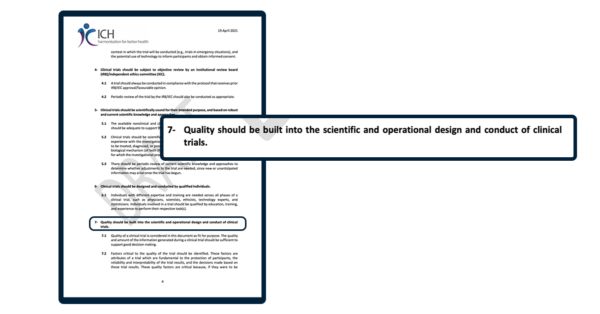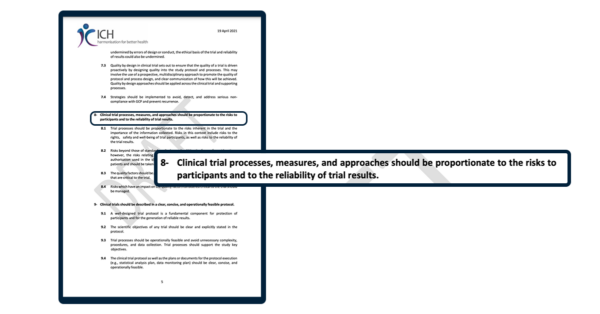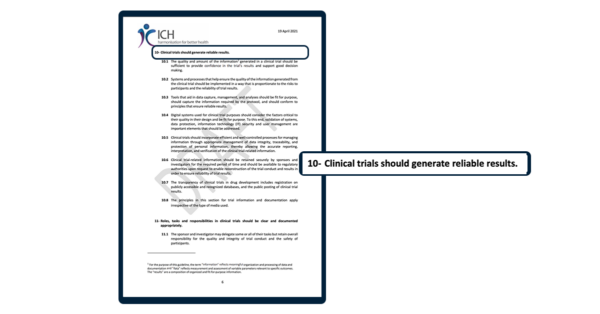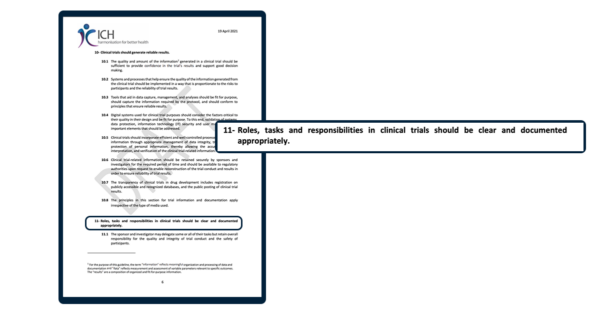Are Clinical Trial Teams Prepared for ICH E6(R3)?
ICH E6(R2), the current global standard for good clinical practice (GCP), went through an update in 2016–and it’s already undergoing another major revision. With how quickly changes are happening, even seasoned clinical trial professionals could find it hard to keep up with all the changes to ICH E6(R3).
The International Council for Harmonisation released a draft of ICH E6(R3) in April 2021, with two annexes to follow in 2022. That means it’s time for clinical research organizations to make sure they have a firm grasp of the basic R3 guidelines before the annexes are added.
Don’t worry–we’ve got you covered. Here are our answers to a few of the most frequently asked questions about ICH E6(R3).
The information presented here is for informational purposes only and is not for implementation in operations. Please consult official ICH E6(R3) guidance documents for operational use.
Why is ICH E6 being revised?
Why is ICH E6(R3) being released just five years after ICH E6(R2) was updated? Dr. Crissy MacDonald of The Avoca Group attributes it to how quickly clinical trials are evolving.
“What we’re seeing is a shrinking timeline of these regulatory guidance revisions, and it’s likely related to the rapid changes in technology’s clinical trial design approaches,” she said on an Applied Clinical Trials webcast.
These changes include the growth of remote and decentralized trials that use technology to let patients participate from home or from local clinics. Other changes include new trial designs, like platform trials where multiple drugs are tested at once.
The ICH wanted to ensure that the Good Clinical Practice principles in ICH E6 apply to many types of trials. They also wanted to make the ICH E6(R3) standards flexible enough for sites to use technology.
What parts of ICH E6 will stay the same?
Some basic principles of ICH E6 haven’t changed. These principles say that clinical trials should:
- Follow the ethical principles first outlined in the Declaration of Helsinki
- Protect participants’ rights, safety, and well-being (R3 uses “participants” rather than “subjects” as R2 did)
- Include voluntary, informed consent from all participants
- Receive approval from an independent Institutional Review Board or Independent Ethics Committee
- Be scientifically sound and based on current scientific knowledge
- Be designed and conducted by qualified individuals (including physicians, scientists, ethicists, technology experts, and statisticians)
- Use a clear, concise, operationally feasible protocol
- Ensure investigational devices are handled according to the protocol
All of these principles should be familiar to clinical research professionals, because they were in ICH E6(R2) before being carried over to ICH E6(R3).
But ICH E6(R3) will also bring several new principles that clinical trial teams have to adopt.
What changes will ICH E6(R3) bring to sites and sponsors?
ICH E6(R3) introduces four principles that weren’t found in ICH E6(R2). They are:
- Quality should be built into the scientific and operational design and conduct of clinical trials.
- Clinical trial processes, measures, and approaches should be proportionate to the risks of participants and to the reliability of trial results.
- Clinical trials should generate reliable results.
- Roles, tasks and responsibilities in clinical trials should be clear and documented appropriately.
We’ve broken down each new principle to determine what it means for clinical trial sites, contract research organizations (CROs), and sponsors.

1. Quality should be built into the scientific and operational design and conduct of clinical trials.
This isn’t the first time the ICH E6 standards have mentioned quality, but the ICH E6(R2) standard read: “Have systems in place to ensure the quality of every aspect of the trial.”
While the R2 standard asks clinical trial professionals to create systems to track trial quality, the R3 standard asks professionals to build quality into the design of clinical trials from the very beginning.
In other words, R3 encourages sites and sponsors to be proactive rather than reactive.
Elvin Thalund, Director of Industry Strategy for Oracle Health Sciences, described it this way for Applied Clinical Trials:
“There’s [currently] a whole secondary process, in this case a TMF (trial master file) process, where now the true regulatory quality is being assessed. The solution could be a system which considers quality from the very beginning. It would include training operational staff members on ICH regulations and implementing quality checks early in the process.”
Building quality into trial training and protocols from the beginning sounds like a promising way to prevent monitors from discovering data quality issues later on. But what does “quality” mean in the context of clinical trials?
The ICH guidelines define quality as “fit for purpose.” In other words, the people who design clinical trials should have the power to decide which parts of the trial are most critical. Which data do they need to see if the treatment worked? Which protocol requirements do the best job of protecting patients?
Investigators and sponsors can then design trial protocols that focus on these “critical-to-quality” factors instead of getting bogged down in extra data or overly specific site requirements.

2. Clinical trial processes, measures, and approaches should be proportionate to the risks to participants and to the reliability of trial results.
This new principle continues R3’s focus on critical-to-quality factors but adds a focus on risk management.
The guideline states that “processes, measures, and approaches” should be “proportionate to the risks”–in other words, that study protocols and study monitoring should focus most heavily on those factors that impact participant safety and the trial’s results.
This principle allows clinical trial sites, CROs, and sponsors to embrace Risk-Based Monitoring (RBM) and Risk-Based Quality Management (RBQM).
Risk-based monitoring accelerates study timelines by acknowledging that all data isn’t equally important.
For example, a wearable device may deliver data from a patient to the site constantly. If a monitor had to verify every piece of data a wearable sent, the trial could drag on and on, preventing patients from receiving treatments they need.
But the monitor still needs to ensure patients are safe and the trial will produce reliable results. The solution? The monitor determines which data is most important to participant safety and the trials’ results and focuses on reviewing that data.
This switch to risk-based monitoring could help trials move faster without compromising participants’ safety or the validity of the trials’ results.

3. Clinical trials should generate reliable results.
At this point, clinical research professionals might think “haven’t we always wanted to generate reliable results”? That’s true, but this principle still marks a change.
In ICH E6(R2) this principle didn’t exist, but the closest equivalent was “Ensure all data is recorded accurately and can be verified.” With ICH E6(R3), the focus has shifted from verifying all data to looking specifically for reliable results.
That means that monitors can decide which data they must review and which data might be extraneous. A subprinciple of this new principle explains what reliable results mean:
“The quality and amount of the information generated in a clinical trial should be sufficient to provide confidence in the trial’s results and support good decision-making.”
This fits together with the other principles that have changed. The ICH E6 standards no longer urge monitors to review all data. Instead, researchers need to collect and monitor the data that regulatory agencies will use to make good, scientifically sound decisions.

4. Roles, tasks and responsibilities in clinical trials should be clear and documented appropriately.
ICH E6(R2) and ICH E6(R3) both require that the people running the trial are fully qualified to perform the tasks they’re in charge of. But R2 only calls out physicians and dentists by name, while R3 mentions “physicians, scientists, ethicists, technology experts, and statisticians.”
R3 acknowledges that while doctors will always be a vital part of running trials, they’re now joined by other clinical trial experts, including experts on technology.
That makes it more important than ever to define the roles and responsibilities of each person so people can work within their area of expertise and not end up with tasks they’re unqualified for.
This new principle is especially essential for decentralized or hybrid trials. As new physicians’ offices and pharmacies get involved in clinical trials, the people who work there will need to know which responsibilities lie with them and which lie with the research site staff.
With this in mind, clinical research staff may want to prepare for the future by building up their digital research skills.
If participants are recording any data at home using wearables or apps, researchers will also need to determine who’s in charge of training participants, answering their questions, and verifying that they’ve collected the data correctly.
ICH E6(R3) requires that tasks and responsibilities be documented and assigned to qualified individuals. It doesn’t dictate which individuals have which responsibilities, though, so clinical research professionals have a great deal of freedom in how they design trials.
Preparing for ICH E6(R3)
ICH E6(R3) doesn’t radically change the clinical trial landscape. Clinical trials still need to be rooted in sound scientific principles, run by qualified professionals, and dedicated to participant safety.
What ICH E6(R3) offers is greater flexibility. Clinical research professionals can use a variety of trial designs, including platform trials or decentralized trials, as long as those designs protect participant safety and data integrity. They can also use risk-based monitoring methods instead of checking every piece of data a trial produces.
Finally, clinical trials can welcome a wide array of experts, from technology-minded clinical research staff to physicians to statisticians. All of these experts can contribute their ideas to produce effective and efficient clinical trials.
If you’d like to learn more about new clinical trial regulations as they arise, sign up for our monthly Florence newsletter, where we break down all the latest news in clinical research.
